
Euphoria!
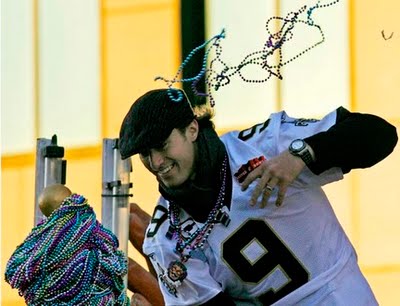 If you’re one of those people who is sensitive to the vibes of your fellow beings, then New Orleans is a great place to be right now. There’s a palpable buzz in the air, a smile on every face, a twinkle in every eye. The city threw a parade for the Saints today, and no one does a parade like New Orleans. It’s carnival season right now anyway, so the parade route was already in place. The various krewes donated the floats, the marching bands added a few more miles to their already dizzying totals for the season. The air was filled with flying beads and the sound of jazz. And everywhere you looked were happy faces—black, brown, white—all united in joy and a poignant sense of relief. I heard someone say today, “Katrina is finally over,” and it struck me as profoundly apt. Yes, the streets are still masses of car-swallowing potholes. Yes,a lot neighborhoods are still struggling. Yes, many of our houses aren’t finished yet. But that nasty air of gloom and despair that has hung over the city for four and a half years has lifted. We’re New Orleans, and we’re finally, really back. 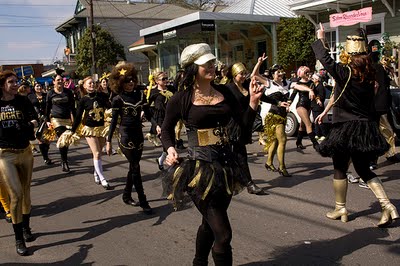 Labels: Katrina, Mardi Gras, New Orleans
Mardi Gras, Cajun Style
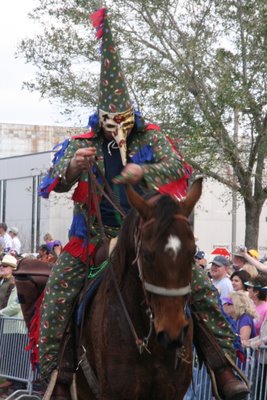 This is how Fat Tuesday is celebrated in the Cajun parishes of southern Louisiana. 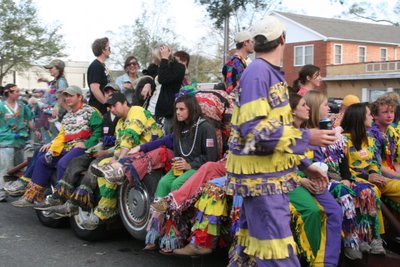 It’s called the Courir de Mardi Gras, and it’s an ancient tradition that dates back to the middle ages. Bands of masked and costumed revelers set out early in the morning on horseback and in hay wagons to rove from farm to farm. Singing and dancing (and drinking—a lot), they beg the ingredients for a traditional gumbo, namely rice, onions, garlic, sausages, and chickens. 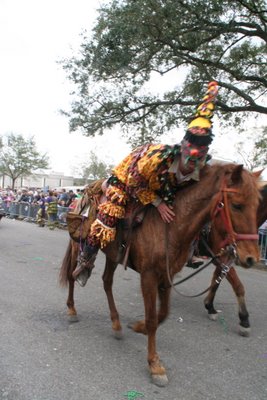 The chickens are the real prizes, since they’re thrown into the air and the riders compete with each other to grab them, scrambling through rice fields and crawfish ditches. The result tends to involve a lot of mud. 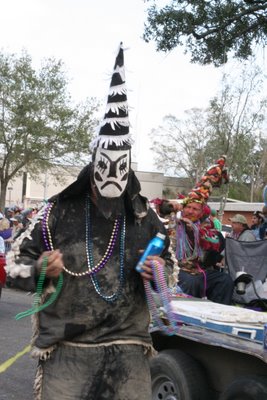 The Cajuns of Louisiana are descendants of the French farmers who settled in what was once called Acadia but is now Nova Scotia, Canada, in 1604 (that’s sixteen years before the sailing of the Mayflower). There they lived and prospered for generations until Britain conquered Acadia and, in 1755, subjected the area to a ruthless “ethnic cleansing.” The villages and farms of the French Catholics were burned, their inhabitants driven out. More than half—men, women, and children by the thousands—died. Many of those who survived made their way to southern Louisiana, where their descendants still form a recognizable community, speaking a strange, eighteenth-century French dialect, cooking incredibly spicy food, making wonderful, foot-tapping music, and riding in the annual courir de Mardi Gras. 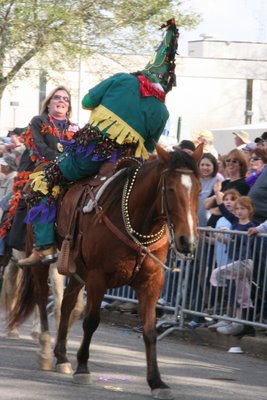 While the participants in the Courir de Mardi Gras are off riding around the countryside, everyone else is in town, listening to Zydeco music, dancing, eating, and waiting for the riders to return. They generally stagger back into town around three o’clock, proudly bearing the results of their quest as they parade through the streets in a rowdy display that typically includes some pretty amazing equestrian acrobatics. Think about dancing (drunk) on top of your saddle while your horse is walking through a roaring crowd. Think about dancing drunk on top of your saddle while holding a squawking chicken. 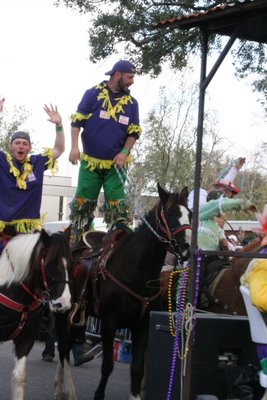 The costumes are traditional, colorful smocks and trousers decorated with patches and fringe. The conical hats are called capuchons, and are meant to mock the pointed hats worn by the noblewomen of the middle ages. One also sees miters and mortarboards, for the whole point (originally) was to make fun of the wealthy, the ordained, and the well educated. The masks are made of window screens and can be quite elaborate. 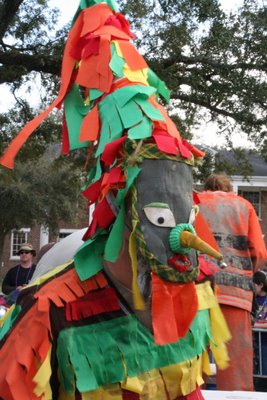 The day ends with a communal feast of gumbo and a fais-do-do, or street dance. And since I sent my book winging on its way (finally!) to New York on Lundi Gras (the Monday before Mardi Gras), I was able to relax and have a very good time. 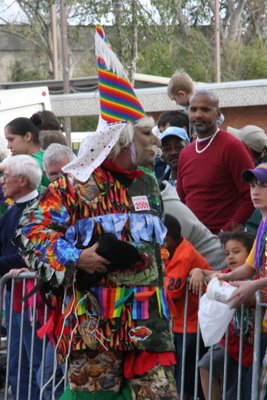 Labels: Mardi Gras
And So It Begins…
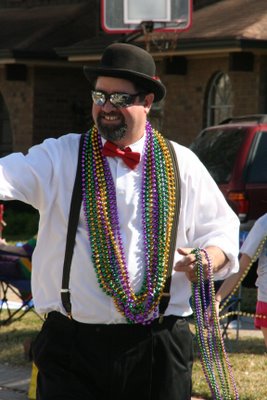 It’s Mardi Gras time again here in New Orleans. Time for the glint of sunlight on a soaring string of beads, the foot-tapping beat of the drums, the biggest of grins on the littlest of kids. 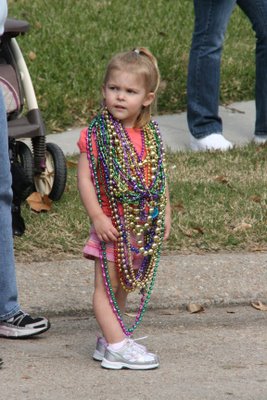 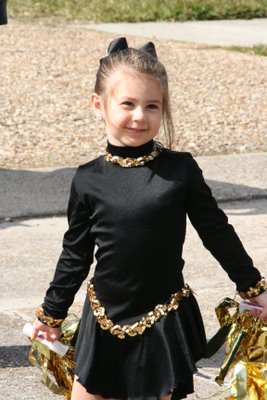 This is the Krewe of Driftwood, a local neighborhood parade that comes at the beginning of the season and is always a blast. The weather was glorious, the day grand. 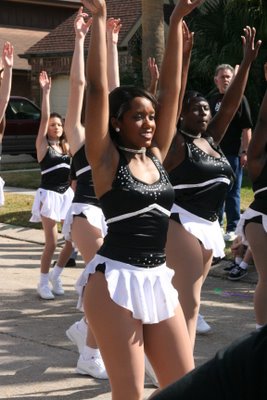 But you know what really sucks? 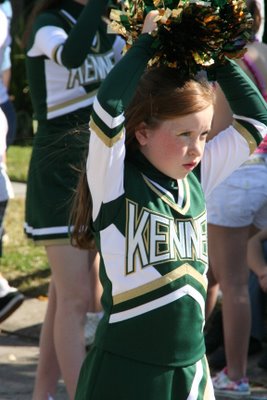 Having a book due five days after Mardi Gras. Labels: Mardi Gras, New Orleans
Courir de Mardi Gras
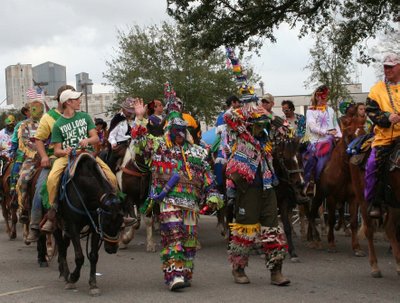 This is Mardi Gras Cajun style. It’s a scene enacted all over Acadia, but this year we decided to attend the Courir de Mardi Gras in the little town of Eunice, about 150 miles west of New Orleans. 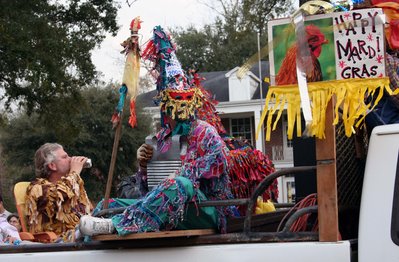 The Cajuns, as everyone knows, are descendents of peasants from the west of France who originally settled “Acadia” in Canada in the 17th century. When the British conquered their part of Canada in the early 18th, the French settlers were subjected to a ruthless “ethnic cleansing.” Some of the survivors eventually made it to Louisiana, where they still form a recognizable group and still speak French (or at least, their own version of French). Many of the Cajuns settled in the swamps and bayous, but there are also “prairie Cajuns” who raise cattle and rice. 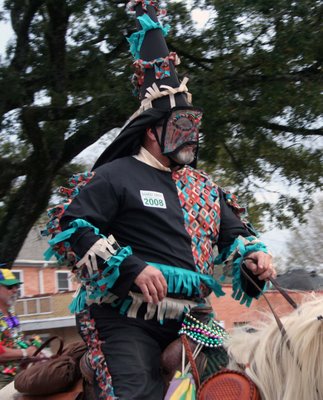 So what exactly is going on here? Well, every Mardi Gras morning, the participants in the traditional Courir de Mardi Gras dress in costumes, mask, and set out on horseback (and on wagon beds—an important component, since the wagons hold the beer and the portapotties). Ranging over the countryside, they sing, dance, and beg at each house until the owners offer them some of the ingredients for gumbo. Since one of the ingredients is chicken, this frequently involves live chickens being tossed into the air. The revelers—usually in increasing stages of intoxication—chase the chickens in a free-for-all that has been likened to (drunk) football players trying to recover a fumble. 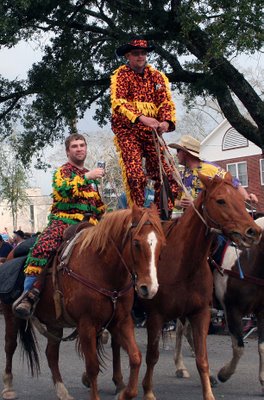 The costume is traditional. The capuchons or conical hats date back to the Middle Ages and are meant to mock the headdresses of medieval noblewomen. The fringes and patches also hark back to the days of tattered poverty. 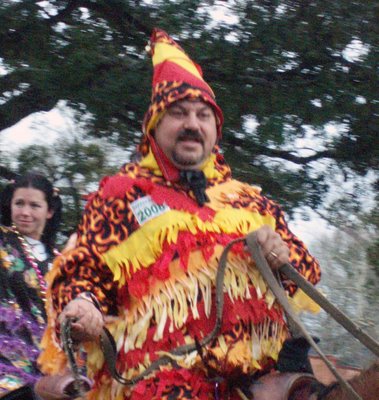 While the Courir participants are out chasing chickens and sausages, the people left in town wander around an arts and crafts fair, listen to live Cajun and Zydeco bands, and dance in the streets. By late afternoon, the Courir returns and parades down Main Street. We’re talking hundreds of riders, dancing on their horses, riding backwards, covered in mud from chasing chickens through crawfish ponds, and still drinking beer. At the end of it all, the chickens, onions, tomatoes, etc, they’ve collected are used to prepare a great communal meal of gumbo. 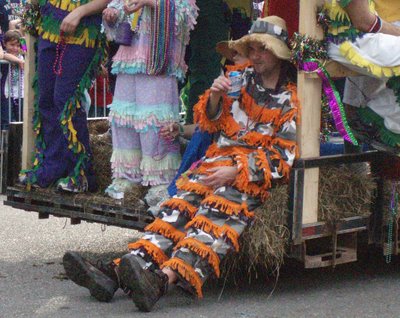 I’ve always wanted to experience the Courir de Mardi Gras, but we actually ended up spending this year’s Mardi Gras in Eunice thanks to a bit of serendipity. A couple of weeks ago an email appeared in my mailbox entitled “Long lost cousin?” You see, genealogy is one of my passions, and I’ve been in touch with a couple in Germany (with access to incredibly well-preserved church records) who have a huge site dedicated to tracing one part of my mother’s family back so far it’s scary. Well, it turns out that “Ed” is my third cousin once removed. A branch of my great-grandfather’s family traveled up the river to Acadia and settled in the Eunice, Mowata, and Roberts Cove area at the end of the nineteenth century. Their descendents have interbred with the Cajuns, so although I don’t have a drop of Cajun in me personally, a lot of these inebriated revelers are my distant cousins. 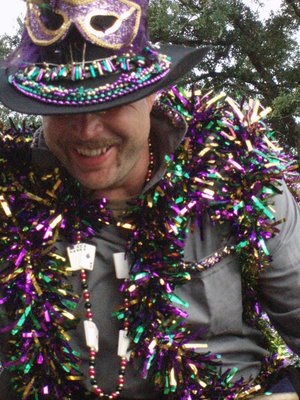 Which is how I ended up spending the day watching a bunch of drunks on horseback chase chickens. 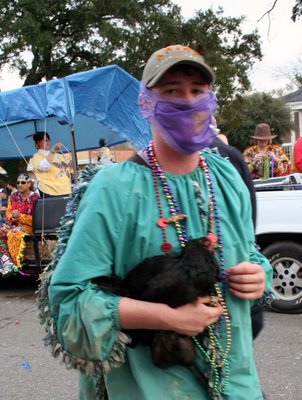 Happy Mardi Gras everybody! Labels: Cajuns, Mardi Gras
Two Celebrations
  Last year’s Mardi Gras was an act of defiance. Despite—or maybe because of—the desperate, post-Katrina life we were all living at the time, New Orleanians stubbornly embraced their most identifiable tradition. Last year, most parades had only a handful of floats with few riders. The school bands were pitifully small, wearing windbreakers instead of uniforms, with three schools sometimes joining together their musicians to form one heartbreakingly small group. Crowds were determined, but thin.  This year, “they” say the crowds were almost up to pre-Katrina strength. More Krewes rolled, and they had more riders. More school bands were back, and some even had uniforms. Both my sister and oldest daughter flew into town for the celebration. It’s been a good Carnival. Then, tonight, Steve and I went to the Vietnamese New Year’s celebration. Yes, the Year of the Pig officially started a week ago, but this is New Orleans, and you can’t expect anyone to try to celebrate anything in the middle of Carnival. So they had the dragon dance and fireworks tonight, and the turnout was incredible. According to the event’s organizers, 85% of the city’s Vietnamese community has returned. These are almost all people who came to this city as refugees, who worked hard to make a new life for themselves only to suffer again beneath Katrina. Now they’re back, and working hard to rebuild their lives, again. It formed an inspiring end to an emotional week.  Labels: Mardi Gras
Mardi Gras, Neighborhood Style
 The Driftwood neighborhood parade rolled today. It’s always one of my favorite parades. The floats are simple affairs, mostly slapped together (amid much beer drinking) the night before. The riders are all kids. The marching groups are all local kids (that's a Marching Club, pictured left, which is different from a marching group). Most of the people standing on the curb are local. Did I mention I live in Driftwood? Against all odds, the Krewe of Driftwood rolled last year, just six months after the storm. They rolled through streets lined with FEMA trailers and PODS and piles of debris. The floats were few in number, the marching groups scraggly, but they rolled, and we all lined up along the streets, many of us in work clothes splattered with paint and drywall compound, and cheered our hearts out.  This year, the FEMA trailers are still there, although much reduced in number. The piles of debris are gone. The gardens are coming back. More than three quarters of the houses are now occupied (if not quite finished). There were more floats, more groups. It still wasn’t back up to what it was pre-K, but we had a great time!  Labels: Driftwood, Mardi Gras, parade
|
































